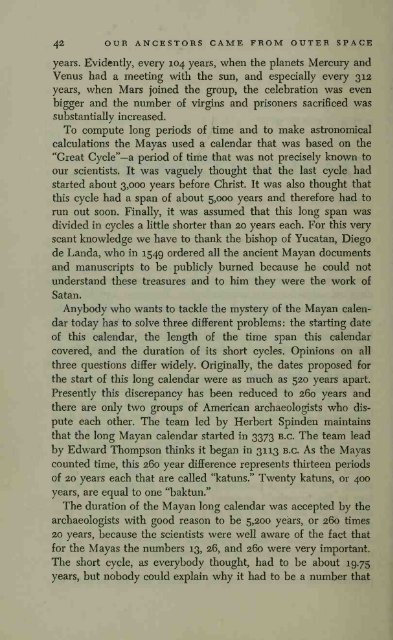You also want an ePaper? Increase the reach of your titles
YUMPU automatically turns print PDFs into web optimized ePapers that Google loves.
42 OUR ANCESTORS CAME FROM OUTER SPACE<br />
years. Evidently, every 104 years, when the planets Mercury and<br />
Venus had a meeting with the sun, and especially every 312<br />
years, when Mars joined the group, the celebration was even<br />
bigger and the number of virgins and prisoners sacrificed was<br />
substantially increased.<br />
To compute long periods of time and to make astronomical<br />
calculations the Mayas used a calendar that was based on the<br />
**Great Cycle"—a period of time that was not precisely known to<br />
our scientists. It was vaguely thought that the last cycle had<br />
started about 3,000 years before Christ. It was also thought that<br />
this cycle had a span of about 5,000 years and therefore had to<br />
run out soon. Finally, it was assumed that this long span was<br />
divided in cycles a little shorter than 20 years each. For this very<br />
scant knowledge we have to thank the bishop of Yucatan, Diego<br />
de Landa, who in 1549 ordered all the ancient Mayan documents<br />
and manuscripts to be publicly burned because he could not<br />
understand these treasures and to him they were the work of<br />
Satan.<br />
Anybody who wants to tackle the mystery of the Mayan calendar<br />
today has to solve three different problems: the starting date<br />
of this calendar, the length of the time span this calendar<br />
covered, and the duration of its short cycles. Opinions on all<br />
three questions differ widely. Originally, the dates proposed for<br />
the start of this long calendar were as much as 520 years apart.<br />
Presently this discrepancy has been reduced to 260 years and<br />
there are only two groups of American archaeologists who dispute<br />
each other. The team led by Herbert Spinden maintains<br />
that the long Mayan calendar started in 3373 B.C. The team lead<br />
by Edward Thompson thinks it began in 3113 b.c. As the Mayas<br />
counted time, this 260 year difference represents thirteen periods<br />
of 20 years each that are called "katuns." Twenty katuns, or 400<br />
years, are equal to one "baktun."<br />
The duration of the Mayan long calendar was accepted by the<br />
archaeologists with good reason to be 5,200 years, or 260 times<br />
20 years, because the scientists were well aware of the fact that<br />
for the Mayas the numbers 13, 26, and 260 were very important.<br />
The short cycle, as everybody thought, had to be about 19.75<br />
years, but nobody could explain why it had to be a number that

















